|
Ireland, Colonisation and Politics
Although much less well-known, the mural tradition in the north of
Ireland is as old as that in Mexico. However, the range of themes and
styles in the Irish context is much more restricted than in Mexico.
For a long time the murals that were painted reflected only one political
point of view --unionism. To understand the mural movement in the north
of Ireland, it is necessary to look historically at both the political
and social context.
The colonial expansion of the British state took place over a number
of centuries, and from an early stage affected Ireland. By the 17th
century the part of Ireland least under British control was the north.
As a result, a policy of 'plantation' was employed as the key strategy
of pacification of the north. Colonists from England and Scotland were
given the best land and built fortified towns. To compound matters,
at the end of the 17th century a series of battles took place in Ireland
between two contenders for the English crown, King James IV, the reigning
monarch, and his opponent (and son-in-law) Prince William of Orange
(in Holland), later King William III. Although not the most decisive
of these battles, the one which became eventually the most celebrated
was the Battle of the Boyne, which occurred in July, 1690.
Agitation for political independence from Britain was common from the
time of the plantation on, and led to numerous attempts, military and
political, by the British to contain insurgence. Thus, after the unsuccessful
United Irishmen rebellion of 1798, the Act of Union was passed, creating
the United Kingdom of Britain and Ireland in 1801. This served to fashion
political allegiances which exist to this day; thus unionists are those
who wish to preserve the political link between Northern Ireland and
Britain, and nationalists are those who wish to sever that link in favour
of a united Ireland.1
The struggle for political independence reached a crescendo in the
final years of the 19th century and first two decades of the 20th century.
Key events in this struggle were the nationalist rebellion of 1916,
the Easter Rising and the subsequent War of Independence. The British
partitioned Ireland in 1921, creating two new states. In the south,
the 'Irish Free State' had a semblance of independence, while in the
north, 'Northern Ireland', power was in the hands of one party only,
the unionists.
Nationalists were in many ways--socially, politically and culturally
--relegated to the margins of society. Eventually, nationalist demands
for equality led to the Civil Rights campaign of the late 1960s. The
failure of the unionist government to concede any reforms spurred the
British government to send in troops to restore order in 1969. It also
led to the re-emergence of the Irish Republican Army (IRA), political
descendants of those who had fought the British in 1916. It was only
a short time before the IRA and British Army were involved in a low-intensity
war. The loyalists were not to be left out; the Ulster Volunteer Force
(UVF) and Ulster Defense Association (UDA) both engaged in military
action aimed in the main at terrorising the entire nationalist community.
For a quarter of a century the activities of these three sets of armies
constituted what was euphemistically referred to as 'the Northern Ireland
troubles'.
Murals in the North of Ireland
In the midst of the political turmoil which led to the establishment
of the Northern Ireland state, working-class loyalists began to paint
murals; the first was in East Belfast in 1908, and depicted the Battle
of the Boyne. With the emergence and consolidation of the Northern Ireland
state, murals became an integral part of the annual celebrations of
this event on July 12 (known as 'the Twelfth'). King Billy, as he is
affectionately referred to, riding his white horse across the River
Boyne, was the most common icon, although other historical events of
loyalist relevance were sometimes painted. Flags, shields and other
heraldic imagery were also common.
The Twelfth represented the 'imagined community' of unionism in its
purest form; what if unionist workers were at loggerheads with unionist
bosses at other times of the year, at least once a year they were able
to celebrate as one big unionist family. Murals were a key element in
celebrating and indeed creating that unity. In that sense they were
more like medieval murals than those of Mexico which had emerged at
around the same time.2 In fact, it is likely that loyalist murals are
unique in this century, emanating as they do from a political ideology
committed to conservatism and the maintenance of the status quo rather
than liberation, anti-imperialism and socialism.
In the late 1960s and early 1970s, the penetration of transnational
capital, which weakened the base of local, unionist capital, British
moves to reform the Northern Ireland state, and finally the military
campaign of the IRA called unionist identity into question. This became
evident on the walls. The number of murals declined, in particular those
depicting King Billy. The heraldic murals continued, but eventually
a new form of murals emerged, which is now the most common form of loyalist
imagery: the militaristic mural. Men wearing balaclavas and brandishing
AK47s, rocket launchers, etc. abound, and the accompanying slogans are
frequently chilling. Loyalism under siege has produced the narrowest
possible set of symbols and messages in its political art.
For most of the existence of the Northern Ireland state, republicans
did not paint murals. The state was founded on unionist privilege and
dominance, and the streets were policed by the unionist police force.
Although nationalists and republicans frequently protested their second-
class citizenship and discrimination, they did not have access to the
walls, even those of their own ghettos.
The republican hunger strike of 1981 changed all that. The strike was
conducted by republican prisoners seeking prisoner of war status, and
it led eventually to the deaths of ten prisoners. Countless nationalists
and republicans took to the streets in support of the prison protest,
and part of that expropriation of public space was the painting of murals
in support of the prisoners.3 The early republican murals related to
the hunger strike and to the armed struggle of the IRA. With the ending
of the hunger strike, republican muralists turned to other themes: state
repression, popular resistance, republican election campaigns and international
solidarity being the most common. Throughout these developments there
was the fluctuating but regular appearance of militaristic symbols in
the murals. Like the loyalists, republicans paraded their hooded men
and weapons. The difference, however, was that, given the greater range
of themes in republican murals, the militaristic images have never dominated
republican imagery to the same extent as they have on the loyalist side.
The existence of such murals revealed the centrality of 'armed struggle'
in the republican strategy. But it is important to note that the anti-imperialist
message was also articulated in the international solidarity murals.
Republican muralists have found echoes of their own struggle in those
of the Palestine Liberation Organisation, the African National Congress
(ANC), the Southwest African People's Organisation and the Sandinistas.
Nelson Mandela, Ché Guevara, Zapata and Lenin have all been seen
on the walls of West Belfast and Derry. It is in this regard that republican
murals differ most from those of loyalists. Loyalism has few international
references; some of those (such as white rule in South Africa) are no
longer in the ascendant, and none of them are noted for their political
art.
Political Art, Political Transition
In February 1990, as the end of apartheid drew near in South Africa,
Albie Sachs, political activist and victim of a state terrorist murder
attempt, addressed some provocative thoughts on culture to his fellow
members of the ANC. He argued for a moratorium on the use of the metaphor
of 'culture as a weapon', a metaphor which he admitted he had himself
used frequently in the past. 'A gun is a gun, and if it were full of
contradictions, it would fire in all sorts of directions and be useless
for its purpose', he argued. Art and literature, on the other hand,
deal in ambiguity and complexity. Artists need to explore the world
around them in all its complexity, and this includes artists who are
members of the liberation movement. However, such a subtle task is not
one to which they are accustomed.
'Instead of getting real criticism, we get solidarity criticism. Our
artists are not pushed to improve the quality of their work; it is enough
that it be politically correct. The more fists and spears and guns,
the better'.4
Coming from anyone less respected, such criticisms could have been
tantamount to disloyalty. But Sachs's purpose was to challenge the liberation
movement, and specifically its artists, to see a new role for themselves
in the transition to a new South Africa.
Four years after this speech, Nelson Mandela was in office as the first
democratically elected President of South Africa. And in the same year
the Irish Republican Army called a cease-fire in a political move to
facilitate inclusive negotiations which would, in their view, lead to
a British withdrawal and the establishment of new structures in Ireland
which were agreed by all Irish people. Loyalist armed groups later called
a cease-fire also. Like South Africa at the time of Sachs's article,
Ireland seemed to have entered a new phase, a phase of transition.
Ireland has its cultural critics too, perhaps not of the same stature
as Sachs, but making similar criticisms from within the anti-imperialist
movement. Gathered around organisations such as Derry Frontline and
2020 Vision (also in Derry), a group of community activists, artists
and young people discussed the role of culture in the liberation struggle
in April 1991.
. . . republican culture might provide a minority with a sense
of solidarity and history. But while it defines itself merely as Brits
Out, it remains purely oppositional, contradictory, and offers no vision
of the future. As such, it cannot claim the status of a liberation culture.
But at the same time, we shouldn't undervalue our culture of resistance.
. . . it has the potential to become the motivation that will develop
and sustain a culture of liberation.5
Similar political situations, similar criticisms. The question is:
what, if any, is the role of political artists in the new climate in
Ireland?
The Tension between Propaganda and Complexity
The first point to make is that such criticisms need not lead to a
rejection of the previous period and its cultural products. In the heat
of struggle, especially when there is armed insurrection and state repression,
the atmosphere is not particularly conducive to artistic subtlety. While
the war rages, political art is indeed a weapon. The current war in
Ireland has lasted a quarter of a century, and there is, as of the time
of writing, no guarantee that the British government will be imaginative
enough or enthusiastic enough to facilitate rapid political change,
despite the unique opportunity they have been presented with as a result
of the republican and loyalist cease-fires. There is thus some debate
about whether the war is in fact over, or, as slogans on militaristic
republican murals in south Armagh state, merely 'on hold'. Given that,
there are limits to the possibility of political artists breaking out
of the more narrowly propagandistic view that 'art is a weapon' and
moving on to more subtle and complex considerations of what the vision
of the future might be. There may be no urgency to cease painting the
guns, uniforms and hooded men which, in the South African context, Sachs
judges to be passé, and which have been prominent in Irish murals.
There is a further constraint on the possibilities of moving from simple
messages to complex investigations in the Irish case. Most of the muralists
on both sides in the north of Ireland are untrained. Yet they have,
in the pursuit of political education and agitation, espoused an art
form which requires certain levels of skill, namely figurative and narrative
painting. Moreover, it is often difficult for untrained muralists to
transfer their articulate and well-rehearsed political views into visual
form without opting for over-used clichés. Despite these limitations,
it must be said that the criticism of the political muralists comes
most often from those who have a political axe to grind, either in the
form of representing a competing political party or ideology, or voicing
the opinions of the art establishment. The latter will often dismiss
muralists because they know nothing about the intricacies of contemporary
art nor have a formal training, failing to recognise that there is often
great skill in the art works that the muralists produce.6
A third point follows, that often those who reject the murals fail
to take the time to look closely at them, and thus miss their complexity.
Like advertisements which appear brash, blunt and unsubtle, political
murals are viewed as bludgeoning the unsympathetic viewer; but, also
similar to advertisements, which have perfected the art of telling complex
stories in deceptively simple ways, political murals often can make
very profound points simply. The complexity is thus often in the eye
of the beholder. For example, it is possible to look at a mural commemorating
the death of a plastic bullet victim and see only soldiers, guns and
innocent children, an apparent collection of simplistic clichés.
But if the victim was a friend, neighbour or relative of the viewer,
then its apparently simple message can conjure up a myriad of emotions
and considerations about life, death, the state, justice, etc. The complex
message of a mural is evident in situ;7 it is those who do not share
the aspirations, grief and living conditions of the people who live
in the neighbourhoods where murals are painted who can most easily dismiss
them as lacking in subtlety.
Murals in a Time of Transition
As well as being the year of the cease-fire, 1994 was the 25th anniversary
of the deployment of British troops on the streets of Belfast and Derry.
Even before the cease-fire, there was an upsurge of republican murals,
most of which referred in one way or other to this anniversary (such
as the reproduction of a black-and-white photograph from 1969, which
showed a young Derry boy with gas mask and petrol bomb). Republican
muralists also used the occasion to point out that twenty-five years
was long enough and that it was time for the British to go home; in
Gaelic, 'slán abhaile' means in effect 'goodbye'.
This trend continued after the cease-fire, with variations of the 'slán
abhaile' mural appearing in Belfast, Derry and south of Newry, on the
border. To first appearances this might seem to be an obsession with
the past. But it must be stressed that it is a case of looking back
in order to look forward. As human rights activists in former dictatorships
in Latin America examine the brutality of the past in order to proclaim
'nunca más', so republican muralists are stating that the future
must be different from the past--no more troops, repressive laws, censorship
and prisons full of political activists.
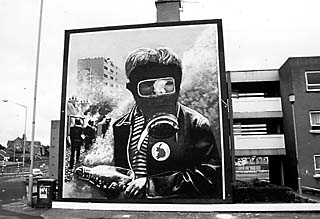
Boy with petrol bomb and gas mask,
painted for the 25th Anniversary of the Battle of the Bogside, Bogside,
Derry, 1994. Photographs of murals by Bill Rolston
Of course, this is not quite the same as painting a detailed vision
of the future, but there are limits to articulating that vision at the
moment. As pointed out earlier, there is no guarantee that the war is
in fact over and that there is a different future to be both articulated
and painted. Moreover, the task ahead is not an easy one for republicans.
They have acquired great skills of expression and persuasion while in
opposition, but they have to go further, to turn slogans into policies,
and general aspirations into programmatic statements that can hold up
in the heat of political debate. They will have to hold on to their
beliefs and principles, and forge alliances with others north and south,
socialist, feminist, nationalist and unionist, who agree with them.
To the extent that they can do this, there will be many themes for republican
muralists.
The prospects seem more limited for unionists. While the British guarantee
of the Union remains, they can continue to stay true to traditional
form, in effect saying 'no' to any political progress. Conversely, if
political developments lead to the removal of that guarantee, the effect
will be to fragment unionism. This is a scary prospect for most unionists.
But in the long run, the break-up of unionism must be good for unionists.
For too many years unionism has been portrayed as a monolith with a
very narrow range of voices. The nuances have been lost. There are a
thousand unionist voices to be heard, and they will not be heard until
unionists are forced to say what they want, not what they don't want.
If and when that day comes, there will be many themes for loyalist muralists
too.
The reaction of loyalist muralists to the peace process is not yet
inspiring. They continue to paint militaristic murals, often with the
accompanying message that the war against the IRA will go on. Some see
in such reactions proof that unionism is virtually incapable of culture
in any broad sense of the word.8 The question is whether what has been
true of the past must necessarily be true of the future. Such narrowness
of artistic imagination and expression is indicative of the siege mentality
of unionism. There is a wide range of issues in unionist communities
which theoretically could find expression in murals, but while the siege
mentality persists, there is merely silence.
One telling indication of the contrast between confident republicanism
and besieged loyalism comes from Derry. In 1993, an education officer
attached to Orchard Gallery had the idea of persuading republican muralists
to paint a mural on boards which could be hung--and could survive!--in
a loyalist area, in return for loyalist muralists painting a mural to
be hung in a republican area. While he got the agreement of republican
muralists, who had even proceeded to the point of discussing a possible
theme for the mural, loyalist muralists could not agree to cooperate.
Interestingly, the plan was resurrected after the cease-fires of 1994,
although, as of the time of writing, no definite agreement on schedule
or theme has been reached.
What could the theme of such murals be? The example of California shows
what is possible where muralists who are rooted in their communities
('organic intellectuals', to use Gramsci's phrase) tackle issues of
importance to those communities. Unemployment, women's rights, drugs,
ethnic history and pride, international issues--these and other themes
have been to the fore. It is not totally unrealistic to hope that such
themes could emerge in the north of Ireland. Some have already been
treated by republican muralists, and loyalist muralists have a long
history of mural painting which might blossom if released from the narrow
confines of the past.
Notes:
1 In addition, loyalists are militant unionists, while republicans
are militant nationalists. The bulk of unionists are Protestant, while
the majority of nationalists are Catholic.
2 Unlike the murals of the Italian Renaissance which expressed the
commonly held beliefs of both rulers and masses, the Mexican murals
portrayed the ideology of a worker, peasant and middle class revolution
against the former ruling class: capitalists, clergy and foreign interests.
Since that time, in the eyes of many, the contemporary muralist has
been identified with poor people, revolution and communism. "Introduction,"
in Eva Sperling Cockcroft and Holly Barnet-Sanchez, eds., Signs from
the Heart: California Chicano Murals (Venice, Calif.: SPARC and Albuquerque:
University of New Mexico Press, 1990), p. 6.
3 See Bill Rolston, Drawing Support: Murals in the North of Ireland
(Belfast: Beyond the Pale Publications, 1992).
4 Albie Sachs, "Preparing Ourselves for Freedom: The ANC and Cultural
Policy," Red Letters, no. 29 (1991): 8.
5 The 2020 Papers (Derry, N. Ireland: Derry Frontline, 1994), p. 12.
6 On the almost total failure of established artists to 'do their bit'
for political insurgents on either side in the North of Ireland (unlike
in the case of Mexico in the 1920s or Nicaragua in the 1980s), see Bill
Rolston, Politics of Painting: Murals and Conflict in Northern Ireland
(Cranberry, N.J.: Associated University Presses, 1991), pp. 51-54.
7 Although it is not necessary to conclude that "(T)aken out of context
it would be difficult to find any real merit in these works," it is
undoubtedly true that "(T)heir strength lies primarily in their location
and their relationship to it." Philip Pocock and Gregory Battcock, The
Obvious Illusion: Murals from the Lower East Side (New York: George
Braziller, 1980), p. 12.
8 'Unsurprisingly, most artists and writers who have emerged from Ulster
Protestantism have tended to move away--physically and mentally--from
the world that bred them. . . . To remain is to be enclosed in a world
where "culture" is restricted to little more than flute bands, Orange
marches and the chanting of sectarian slogans at football matches.'
Ronan Bennett, "An Irish Answer," The Guardian Weekend, 16 July 1994,
p. 55.
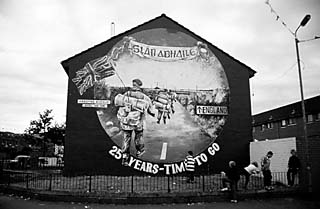
"Slán Abhaile," 25th anniversary
of the deployment of British troops in Northern Ireland, Ardoyne,
Belfast, 1994
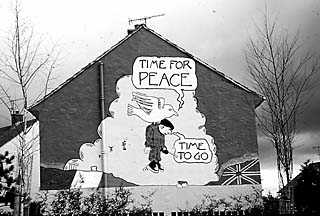
"Time for Peace, Time to Go," 25th
anniversary of deployment of British troops in Northern Ireland,
Ballymurphy, Belfast, 1994
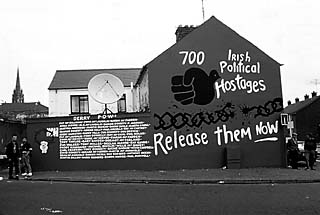
"Release Republican Political Prisoners,"
Bogside, Derry, 1994
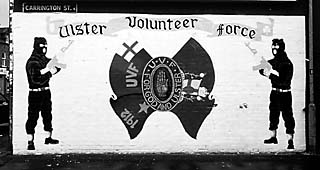
Armed members of the Ulster Volunteer
Force, East Belfast, 1994
|